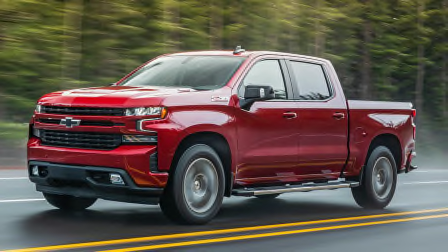How to Save Money When Buying Tires
Exclusive survey reveals the best ways to lower the cost for tires, combined with expert tips on price matching, rebates, installation costs, and smart shopping strategies

Buying new tires can be a significant expense, but it’s also a crucial investment in your vehicle’s safety and performance. Instead of viewing it as a chore, consider it as an opportunity to find the perfect set of tires at the best possible price. By arming yourself with the right knowledge, you can make a confident purchase that keeps you safe on the road without overspending.
Consumer Reports can help, combining our experts’ insights and the findings from our latest tire survey. The survey collected feedback from 47,706 members who shared their experiences buying over 52,000 sets of tires.
Top Pick Tires
See the best car, SUV, and truck tires.
What Drives Tire Purchases
Most buyers (64 percent) replaced their tire sets when their current tires were worn, and the second most common reason was premature or irregular wear (14 percent). A flat tire led to 9 percent of purchases; similar percentages cited performance issues (9 percent) and wanting a different type of tire (8 percent).
These findings offer a few lessons:
Ideally, tires will serve for several years—assuming proper maintenance and good fortune in avoiding punctures and other damage. To increase the odds that you truly get your money’s worth, look at the treadwear estimates in our ratings. These data-derived predictions for most tire types are based on our rigorous vehicle treadwear test, in which we run tires around the clock, over 1,000 miles a day, while following stringent protocols for care. Car and truck tires are run to 8,000 or 16,000 miles (depending on the tire type). Based on the carefully measured wear, we predict their service life.
To ensure you get the most from your tires, we recommend checking and adjusting the tire pressure monthly. All tires lose a little pressure over time, and outside temperatures affect air density and consequently tire pressure. Notably, pressure drops with temperatures (about 1 psi per 10 degrees), making it particularly important to be diligent in cold months. Proper inflation will help the tires wear evenly, while bolstering safety.
The other key maintenance chore is to rotate the tires every 5,000 to 7,500 miles. This helps them to wear evenly, making up for the extra wear the front tires experience and compensating for minor suspension alignment issues. Just like with your personal health, preventive measures add longevity and ultimately save money.
Tire Shopping Priorities
In choosing their next tires, CR members consider these factors to be very important: wet grip (74 percent), handling (73 percent), treadwear (66 percent), and ride comfort (57 percent). Even facing significant costs, these shoppers clearly focused on performance factors over price, which was considered very important to just 38 percent of survey respondents.
These priorities align with how our testers look at tire value as being the nexus of price, performance, and longevity.
Pszczolkowski advises starting with the Overall Score in CR’s tire ratings, which combines all test results and owner satisfaction. Then look to the predicted tread life, and finally the price. Better tires are worth paying extra for . . . especially if they last longer than alternatives, thereby lowering the cost per mile. Just make sure you take good care of your tires to truly get your money’s worth.
Michelin is by far the most purchased tire brand among CR members. It’s no wonder: Michelin holds the top position in many of the categories we test. Michelin tires typically cost more, with prices above those of many other household names, but the added cost can often be justified when comparing track performance and projected treadwear. As further proof, Michelin earned a much-above-average rating for owner satisfaction in each of the four tire types in the survey. However, when you look through our tire ratings, you’ll find that there are often strong-performing alternatives worth considering. (Read more about tire brand satisfaction.)
How to Save on Tires
In general, members were satisfied with tire retailers. Almost half of the members (54 percent) who took our survey in 2024 said that considering all factors, they were completely satisfied with their tire purchase experience, and 57 percent were completely satisfied with their tire installation.
The two factors that contributed most to overall satisfaction were installation quality and sales help.
To get the best price, start shopping before you need to replace the tires urgently. Circumstances will dictate whether you’re shopping for one, two, or four tires. Know that buying a set of four is usually most cost-effective, both in terms of standard pricing and special deals, such as 4-for-3 special offers and rebates.
Shopping while you still have some tread left (4/32” is a good time to start) allows time to check prices at your preferred retailers and time to seek rebates from tire makers. Rebates are fairly common for buying sets of four, and they can be readily found on the websites for tire companies and tire retailers. If there isn’t a rebate available now, try to wait until the beginning of the next month, because they do pop up with great regularity.
Another reason to have some flexibility on timing is that your local store might not have the specific model and size in stock. This is always a possibility given the myriad sizes that each model is available in. However, retailers can usually get tires in stock rather quickly.
When you’re ready to buy, try negotiating the price from your local store. The majority of survey respondents (86 percent) did not negotiate, but among those who did, 63 percent were successful at getting a better deal. The median savings for these savvy shoppers was $37 per tire, with more than half saving $100 or more. It is worth trying. Another strategy is to press for price matching if you find a lower price elsewhere.
Be sure to ask about free perks. Most members (82 percent) who purchased or installed tires at a retailer received at least one free perk or service. Among all members, about half got free tire rotation (47 percent) or tire balancing (47 percent). Almost as many got free tire mounting (43 percent), while about a third got free tire checks or flat tire repairs (each 31 percent). These extras encourage store loyalty, but they also promise real savings. Our favorite among them is the free tire rotation. Over the tire’s life, this can save hundreds of dollars, and it encourages good tire maintenance.
What About Road-Hazard Protection?
A road-hazard warranty—protection that typically provides a prorated replacement for tires damaged before their traditional tread life has expired—is another fairly common perk. Almost half of the CR members (49 percent) who had road-hazard/tire service warranties received these protections free from the tire makers. For models without this protection, it may be a free perk from the retailer. Otherwise, it can be added like an extended warranty at the point of purchase.
Among those who actually purchased a road-hazard/service contract warranty, the median cost for a set of four was $67 for all-terrain, $54 for all-season, $49 for all-weather, $47 for ultra-high-performance summer, and $47 for snow/winter tires. A quarter (25 percent) of road-hazard/service contract warranties had been used when members were surveyed.
“Road-hazard protection is often worth the peace of mind,” says Gordon Gingras, an automotive engineer at Consumer Reports. “This is especially true on expensive tires, tires with short sidewalls that are prone to damage, and if you have a history of getting flat tires.”
Bottom Line
Start shopping for tires by identifying models that deliver on the safety-related attributes that mean the most to you, such as wet braking grip, winter traction, and resistance to hydroplaning (when water gets between the tire and the road). Then focus on long treadwear for the category and getting a good deal from a reputable dealer. There are often discounts available from the tire manufacturer and tire retailer websites, most often in the form of savings on a complete set. And remember, it can’t hurt to try negotiating.




















